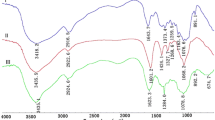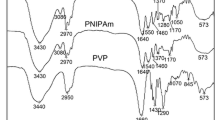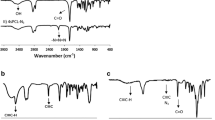Abstract
Acrylate-terminated poly (ethylene glycol) (PEG) macromer was prepared by the reaction of PEG with acryloyl chloride. Photopolymerization of PEG macromer resulted in the formation of cross-linked PEG network. Interpenetrating polymer networks (IPNs) based on PEG and poly(acrylic acid) (PAA) was obtained via template polymerization of AA to the PEG network by UV curing. The swelling degree of the IPNs hydrogel increased with an increase of pH value due to the association-dissociation between carboxylic acid of PAA and ether of PEG through hydrogen bonding. The swelling-deswelling behavior proceeded reversibly for the IPNs upon changing pH. Release of indomethacin from the IPNs demonstrated “on-off” regulation with pH fluctuation.
Similar content being viewed by others
References Cited
Andini, S., Ferrara, L., Maglio, G. and Palumbo, R., Synthesis of block polyesteramides containing biodegradable poly (L,L-lactide) segments.Makromol. Chem. Rapid Commun., 9, 119–124 (1988).
Brannon-Peppas, L. and Peppas, N. A., Solute and penetrant diffusion in swellable polymers: IX. The mechanisms of drug release from pH-sensitive swelling-controlled systems.J. Controlled Release, 8, 267–274 (1989).
Brondsted, H. and Kopecek, J., Hydrogels for site-specific oral drug delivery: Synthesis and characterization.Biomaterials, 12, 584–592 (1991).
Deng, X. M., Xiong, C. D., Cheng, L. M. and Xu, R. P., Synthesis and characterization of block copolymers from D,L-lactide and poly(ethylene glycol) with stannous chloride.J. Polym. Sci., Polym. Lett. Ed., 28, 411–416 (1990).
Hoffman, A. S., Afrassiabi, A. and Dong, L. C., Thermally reversible hydrogels: II. Delivery and selective release of substances from aqueous solutions.J. Controlled Release, 4, 213–222 (1986).
Ishihara, K., Hamada, N., Kato, S. and Shinohara, I., Photoresponse of the release behavior of an organic compound by a azoaromatic polymer device.J. Polym. Sci. Polym. Chem. Ed., 22, 881–884 (1984).
Kim, S. H., Ha, J. H., Jung, Y. J. and Cho, C. S., Drug release from bioerodible hydrogels composed of poly-ε-caprolactone/poly (ethylene glycol) macromer semiinterpenetrating polymer networks.Arch. Pharm. Res., 18(1), 18–21 (1995).
Kost, J. (ed)Pulsed and Self-Regulated Drug Delivery (CRC, Boca Raton, 1990).
Kost, J. and Langer, R., Responsive polymeric delivery systems.Advanced Drug Delivery Reviews, 6, 19–50 (1991).
Kwon, I. C., Bae, Y. H., Okano, T., Berner, B. and Kim, S. W., Stimuli sensitive polymers for drug delivery systems.Makromol. Chem. Macromol. Symp., 33, 265–277 (1990).
Langer, R., New methods of drug delivery.Science, 249, 1527–1533 (1990).
Nishi, S. and Kotaka, T., Complex-forming polyoxyethylene: poly(acrylic acid) interpenetrating polymer networks III. Swelling and mechanochemical behavior.Polymer Journal, 21(5), 393–402 (1989).
Pavia, D. L., Lampmam, G. M. and Kriz, G. S., in:Introduction to Spectroscopy. W. B. Saunders Co., Philadelphia, (1979).
Siegel, R. A. and Firestone, B. A., pH-dependent equilibrium swelling properties of hydrophobic polyelectrolyte copolymer gels.Macromolecules, 21, 3254–3259 (1988a).
Siegel, R. A. and Firestone, B. A., Progress toward an implantable, self-regulating, mechanochemical insulin delivery system. Proc. Symp. Contr.Rel. Bioact. Mater., 15, 164–167 (1988b).
Sperling, L. H.,Interpenetrating Polymer Networks and Related Materials.Plenum Press, New York (1981).
Suzuki, A. and Tanaka, T., Phase transition in polymer gels induced by visible light.Nature, 346, 345–347 (1990).
Author information
Authors and Affiliations
Rights and permissions
About this article
Cite this article
Kim, IS., Kim, SH. & Cho, CS. Drug release from pH-sensitive interpenetrating polymer networks hydrogel based on poly (ethylene glycol) macromer and poly (acrylic acid) prepared by UV cured method. Arch. Pharm. Res. 19, 18–22 (1996). https://doi.org/10.1007/BF02976814
Received:
Issue Date:
DOI: https://doi.org/10.1007/BF02976814




